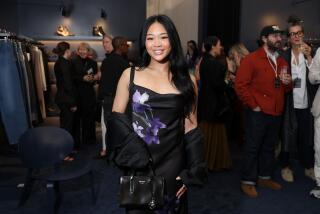Vying for Attention in Baby Niche
- Share via
As executives at Toys R Us Inc. consider getting out of the toy business and focusing instead on their Babies R Us division, their competitors are already moving fast in the world of blankets and cribs.
Wal-Mart Stores Inc. and Target Corp., which have hurt Toys R Us with deep discounting on toys, are expanding their baby departments. And Burlington Coat Factory has nearly 300 Baby Depot shops within its stores.
“Toys R Us thinks that Babies R Us will be their savior, but the question is: How are they going to meet the increased competition?” said Chris Byrne, a New York-based independent toy consultant.
Bob Waller, president of the Juvenile Products Manufacturers Assn., a Mount Laurel, N.J.-based industry trade association, noted that discounters wanted a larger share of the $6-billion baby business, which he estimates is growing by as much as 6% a year.
Consumers shopping for baby products recently were very price conscious -- a fact retailers are well aware of.
“Price is really my main focus, just because of the way the economy is right now,” said Cara Parsons, shopping at a Wal-Mart in Rocky Hill, Conn., for baby products. She has two children, a 2-month-old son and 3 1/2 -year-old daughter.
Cindy Amato of Fairless Hills, Pa., buys items like baby wash and shampoo for her 10-month-old at Wal-Mart because its prices are lower, but she likes to buy bigger items such as car seats and strollers at Babies R Us.
“Not that Wal-Mart doesn’t have quality, but Babies R Us is strictly a baby store,” she said.
Babies R Us -- the nation’s largest baby products chain with 200 stores that’s considered the crown jewel of Toys R Us -- has kept ahead of its competition. Last year, the division had an 11% sales increase, reaching $1.76 billion. Meanwhile, Toys R Us’ revenue in the U.S. fell 4% to $6.48 billion.
Unlike its discount rivals, Babies R Us has such amenities as expectant mother parking, which is near the front entrance of the stores, and special nursing rooms.
It also offers a wider selection than that found at discounters -- stores typically range from 24,000 to 37,000 square feet and carry about three times the number of baby products that mass merchants have, according to Sean McGowan, an analyst at investment firm Harris Nesbitt.
A typical Babies R Us store has 100 different car seats and 30 different styles in baby jumpers, for example. Babies R Us also is fast to jump on trends -- one of the latest is strollers that match the patterns and colors of cribs and other accessories.
But the discounters’ baby sections are growing. At a Target store in Brooklyn, there were more than 10 aisles of baby products, such as highchairs, baby strollers and nursing accessories, with well-known brands such as Graco and Evenflo.
Some consumers prefer the logistics at Babies R Us.
Wal-Mart “is very large to maneuver with two children,” said Jennifer Mohring of East Brunswick, N.J., who has a 4-month-old son and a 3-year-old daughter. She was at a shopping center that had both a Wal-Mart and a Babies R Us.
Analyst McGowan, who recently visited the baby department at a Target store in New Jersey, believes discounters’ current displays don’t offer the same kind of emotional appeal as Babies R Us stores, which start with an open layout that enables shoppers to see the whole store from the entrance. They also have cribs and other furniture displayed in model rooms and generous seating in the baby registry area.
Babies R Us might have an easier time fending off competition than Toys R Us did because of the inherent differences between the two types of merchandise. Unlike toys, most of whose sales come during the fourth quarter, the baby business is year-round. And it’s less dependent on big hits to drive sales.
That makes it tougher to “jump in and out of,” said Bill Sims, a toy analyst at Smith Barney. Last holiday season, discounters, particularly Wal-Mart, cut prices on the hottest holiday toys in September, six weeks earlier than the year before. That hurt Toys R Us’ sales and profit.
Still, Byrne said, discounters can shift their markdown strategy if Toys R Us focuses it efforts on its baby business.
This “could give discounters impetus for them to get more competitive,” he said.
Another difference between baby products and toys is that parents shop at stores like Babies R Us for only about two years, until their children outgrow the merchandise. But they’re shopping for toys for 10 years or more.
That means retailers need to be continually wooing a new generation of consumers.
Waller estimates that parents spend an average of $1,700 to $2,500 to outfit the nursery and buy other products for their first-born child. The figure doesn’t include clothing -- an area where Babies R Us and its rivals are also competing.
More to Read
Inside the business of entertainment
The Wide Shot brings you news, analysis and insights on everything from streaming wars to production — and what it all means for the future.
You may occasionally receive promotional content from the Los Angeles Times.










